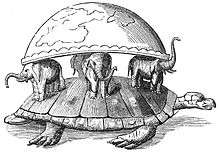World Elephant
The "world-elephants" are mythical animals which appear in Hindu cosmology. The Amarakosha (5th century) lists the names of eight male elephants bearing the world (along with eight unnamed female elephants). The names listed are: Airavata, Pundarika, Vamana, Kumunda, Anjana, Pushpa-danta, Sarva-bhauma, Supratika. The names of four elephants supporting the earth from the four directions are given in the Ramayana : Viroopaaksha (east), Mahaapadma (south), Saumanasa (west), Bhadra (north).[1][2]

Brewer's Dictionary of Phrase and Fable lists Maha-pudma and Chukwa are names from a "popular rendition of a Hindu myth in which the tortoise Chukwa supports the elephant Maha-pudma, which in turn supports the world".[3] The spelling Mahapudma originates as a misprint of Mahapadma in Sri Aurobindo's 1921 retelling of a story of the Mahabharata,
The popular rendition of the World Turtle supporting one or several World Elephants is recorded in 1599 in a letter by Emanual de Veiga.[4] Wilhelm von Humboldt claimed, without any proof, that the idea of a world-elephant maybe due to a confusion, caused by the Sanskrit noun Nāga having the dual meaning of "serpent" and "elephant" (named for its serpent-like trunk), thus representing a corrupted account of the world-serpent.[5][6][7]
Love and Death
On the wondrous dais rose a throne,
And he its pedestal whose lotus hood
With ominous beauty crowns his horrible
Sleek folds, great Mahapudma; high displayed
He bears the throne of Death. There sat supreme
With those compassionate and lethal eyes,
Who many names, who many natures holds;
Yama, the strong pure Hades sad and subtle,
Dharma, who keeps the laws of old untouched.[8]
See
- World Turtle
- Dikpalas
- Discworld – Fantasy book series
References
- "Monier-Williams, ''Indian Wisdom'', p. 430f". Books.google.com. Retrieved 2013-04-14.
- "Maharshi Valmiki, Ramayana, Bala Kanda, Sarga 40, Verses 12--22". Retrieved 2018-12-14.
- Brewer's Dictionary of Phrase and Fable, 15th ed., revised by Adrian Room, HarperCollins (1995), p. 1087. also 14th ed. (1989).
- J. Charpentier, 'A Treatise on Hindu Cosmography from the Seventeenth Century (Brit. Mus. MS. Sloane 2748 A).' Bulletin of the School of Oriental Studies, University of London 3(2) (1924), pp. 317-342, citing John Hay, De rebus Japonicis, Indicis, and Peruanis epistulæ recentiores (Antwerp, 1605, p. 803f.)
- Sadashiv Ambadas Dange, Glimpses of purāṇic myth and culture (1987), p. 70.
- "INDOLOGY archives - April 2010 (#17)". Listserv.liv.ac.uk. Retrieved 2013-04-14.
- "INDOLOGY archives - April 2010 (#33)". Listserv.liv.ac.uk. Retrieved 2013-04-14.
- "Love and Death: Love and Death". Sacred-texts.com. Retrieved 2013-04-14.